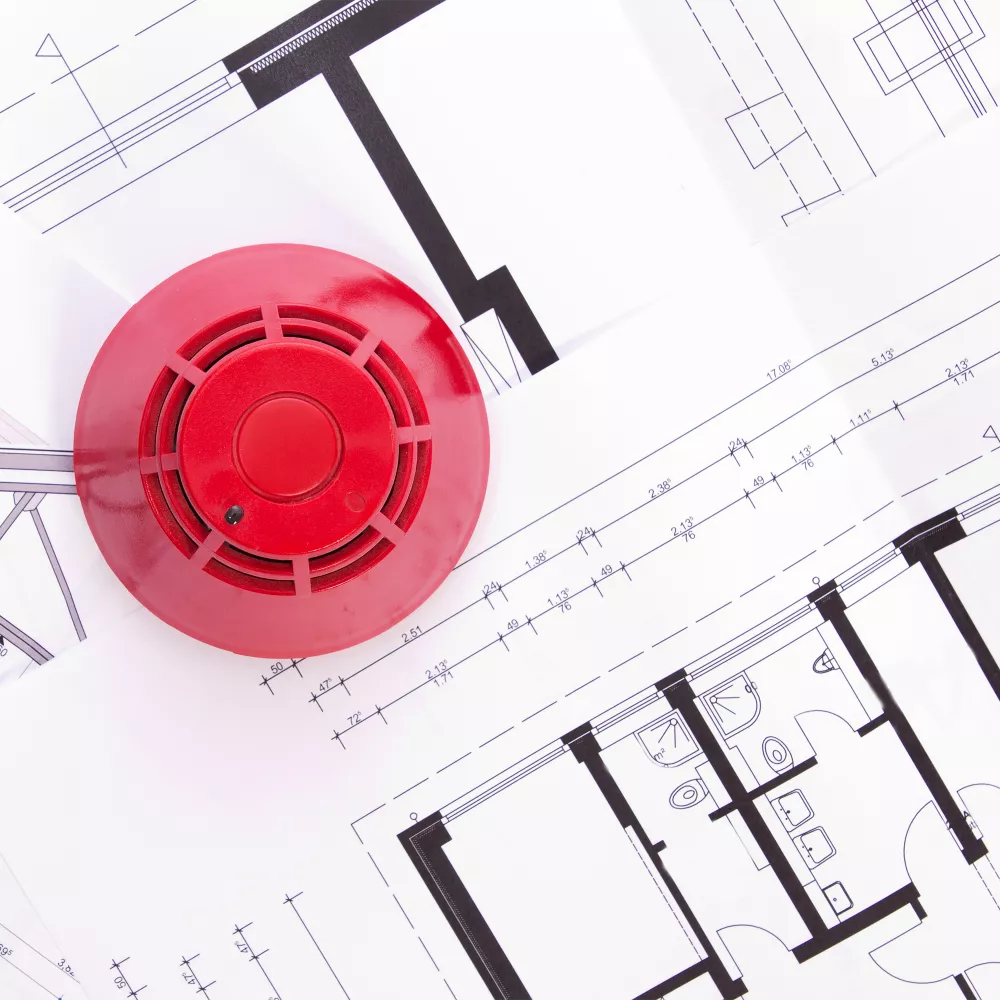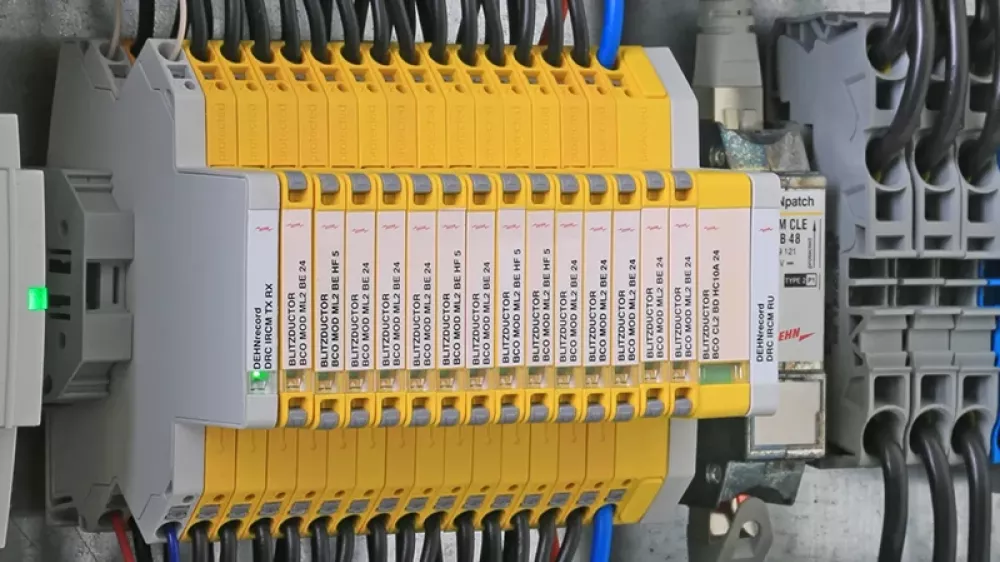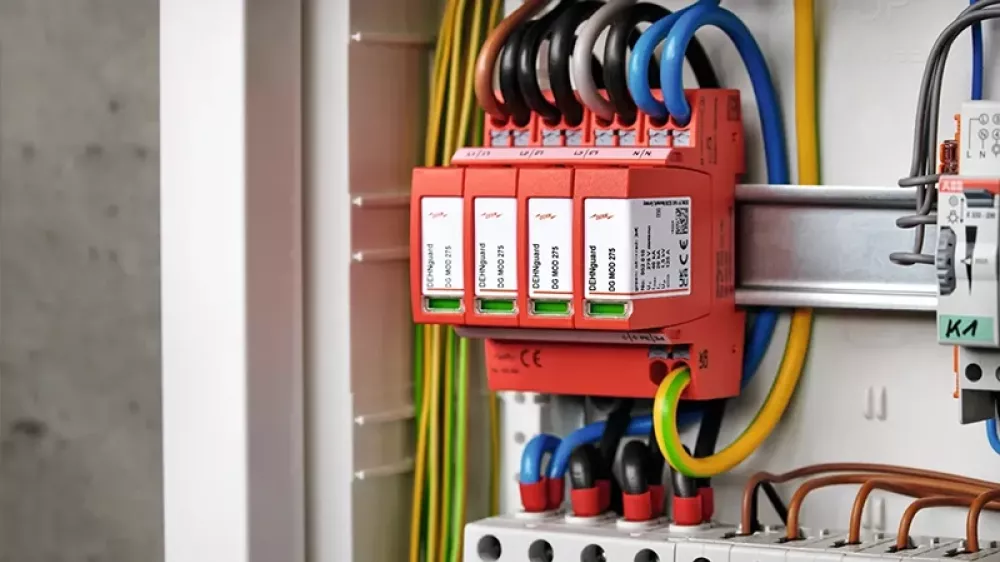Protection of fire alarm systems
Thought through from the outset. It is crucial for building constructors and planning engineers to consider the protection of fire alarm systems at an early stage. Lightning and surge protection is not only an important part of preventive fire protection, but also essential for increasing the function and availability of fire alarm systems.
Consider surge protection in your planning in good time and protect yourself against unnecessary risks and costs in the long term. We are here to help you!
The role of the fire alarm control panel in modern fire protection
Fire alarm systems are an important part of hazard prevention and play a key role in building technology. They are used for early fire detection and help to prevent or minimise damage. They also have the task of automatically signalling faults or shutdowns to a 24-hour alarm centre.

Functions at a glance
At the centre of a fire alarm system is the fire alarm control panel. This is where all the signals come together and the system components are supplied with energy. Incoming signals are analysed and alarms, fire alarms, fault notifications and control signals are generated. It is also possible to control devices that support the fire brigade in their operations. Fire alarm systems indicate alarms, faults and shutdowns and forward them to defined locations. Manual queries, switching operations and programming processes are also carried out via the fire alarm system.
Fire alarm systems integrated at an early stage are crucial for building protection
Fire alarm systems are essential in modern and complex building types. Examples include industrial buildings, data centres, educational facilities, nurseries, hospitals, places of public assembly, sales outlets and hotels. Highly sensitive components and cables extending beyond the building also require layered protective measures to prevent faults.
In summary: wherever a lightning protection system in accordance with IEC 62305 is required, the fire alarm system should be integrated into the lightning protection zone concept in accordance with IEC 62305-4 at an early stage.
A protected fire alarm system not only ensures system availability, it also avoids cost-intensive false alarms. Fewer breakdowns mean lower repair costs, fewer technician call-outs, no outlay for fire watches and greater safety for the building. Surge protection measures for fire alarm systems also contribute to the comprehensive protection of human life.
Safely standard-compliant
Our solutions and products comply with IEC 61643-11 and Part 21. Learn more about the requirements and how you can meet them with our solutions. Further specifications on the safety of people, animals and technology are contained in the IEC 62305 series of standards, as well as national standards, regulations and laws.
Enquire with the manufacturer of the fire alarm system before installation and clarify the options and correct installation with the experts.
Surge arresters for IT are usually installed in series with the connecting cable. If a surge arrester is overloaded due to the nominal parameters (longitudinal current, nominal voltage) being exceeded or due to multiple surge events, it disconnects the line of the system circuit or the terminal equipment for protection. The signal is interrupted as a result.
Despite the disconnection of the signal circuit, the system is still protected. In order to ensure the availability of a fire alarm loop at all times, it is necessary to run the outgoing and return lines redundantly over two separate surge protective devices.
The standards IEC 62305 and EN 50310 are important standards for safety technology in relation to lightning and surge protection. IEC 62305-3 in particular describes the necessity of equipotential bonding measures in buildings with an external lightning protection system.
Under item 6.2, lightning equipotential bonding, it essentially states that all electrically conductive installations that run into the building from outside must be incorporated into the equipotential bonding. With electrical cables, this must be implemented using surge protective devices.
Since not only conducted surges but also high electromagnetic interference fields are to be anticipated from a lightning strike, it is sensible to implement a lightning protection zone concept as per IEC 62305-4. If this is not possible due to structural restrictions, surge arresters should be installed in the incoming and outgoing wires at least at the fire alarm control panel to protect the function. The fire alarm control panel with its enclosure constitutes a new lightning protection zone in this concept. As soon as a line is not protected on a device to be protected, surges can be induced here and damage and destroy the device.
Yes, transient overvoltages can be induced and cause problems with electrically conductive cable shields and drain wires. Cable shields must therefore also be included in equipotential bonding.
In new installations, for reasons of future flexibility, cables are often installed with a higher number of wires than the current situation requires. Also, the shielded version is often used for EMC reasons to reduce the effect of the interference on the active cores and the interference emitted from the active cores to neighbouring systems. If the building has an external lightning protection system and metal conductors exit from it, then section 6.2.3 "Lightning equipotential bonding for external conductive parts" of lightning protection standard IEC 62305-3
prescribes that all external conductive parts – in addition to pipelines, this also includes cables and conductors, for example – must be incorporated into the equipotential bonding. If these cables are routed from one building to another building, one must also remember that no impermissible compensating currents may flow on the shield or unwired conductors. In order to prevent these compensating currents, a proven solution is not to connect the conductors directly to the equipotential bonding on both sides, but instead to earth them at a building transition point directly and at the other input indirectly via surge arresters.
The standard IEC 60364-5-53 describes the installation of surge protective devices. The necessity of additional protective devices is presented here. If, for example, the cable length of 10 metres to the upstream surge protection is exceeded, additional protective devices should be installed in the sub-distribution boards and on the terminal equipment in electrical installations.
Surge arresters for information technology must be tested in accordance with the IEC 61643-21 product standard. This standard describes how often a surge arrester must operate and how much energy it must be able to dissipate. The standard describes different forms of impulses that need to be considered. These include:
- The largest energy input such as the direct lightning strike
- The electromagnetic impulse of lightning
- Switching overvoltages
If you compare these three pulse shapes, it becomes clear that a surge arrester tested in accordance with the standard must process different energies. The product standard therefore scales the service life into different pulse categories.
The combined arrester Blitzductor XT is tested in impulse categories D1, C2 and C3 and must be able to handle at least 2 x 2.5 kA 10/350 µs of impulse (direct lightning strikes) or 10 x 5 kA 8/20 µs of impulse (electromagnetic impulses) or 300 x 1 kA 8/20 µs of impulse (switching overvoltages). In practice, the waveforms occur in a mixed fashion, and it depends on the location in which the arrester is installed, and which impulses occur there.
The standards relevant to the particular field of application must be taken into consideration in terms of the inspection of alarm systems. This includes IEC 62305, for example. IEC 62305-3 specifies a maximum inspection cycle of four years, depending on the lightning protection class.



